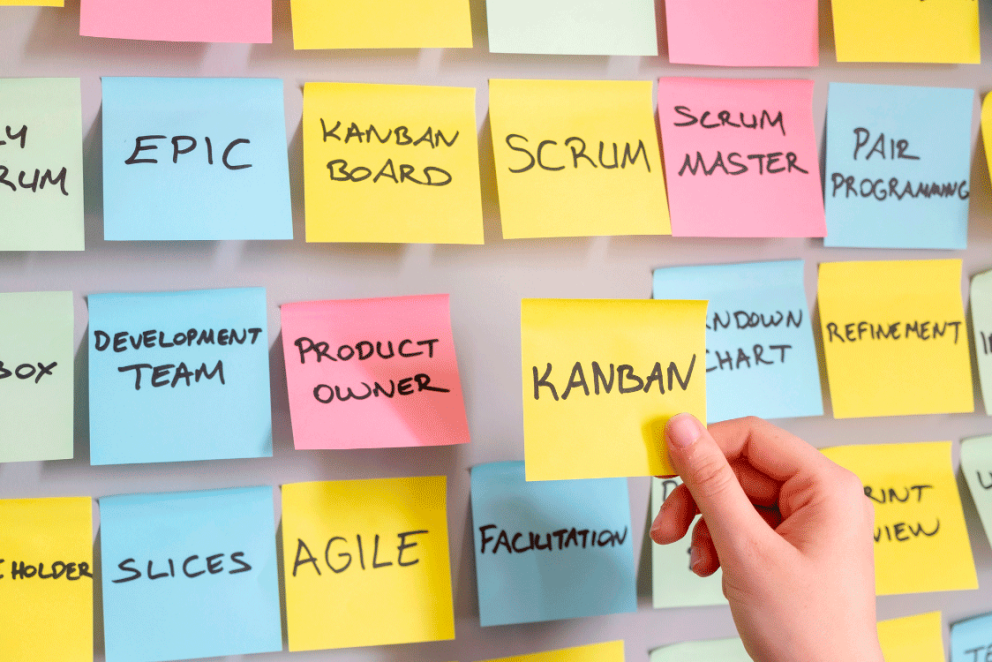Table of contents


What is Agile Management? Methods, tools, and implementation
28 Sep 2023
Updated on 22 Oct 2024


28 Sep 2023
Updated on 22 Oct 2024
Table of contents
In a constantly changing and evolving business world, Agile Management has become an increasingly recurring term. But do you really know what Agile Management means, or is it just a buzzword?
Don’t worry, in this article, we will delve deep into the world of Agile Management, the most popular methodologies, and how to implement this working philosophy in your company.
Agile Management is a philosophy and management approach that focuses on flexibility, collaboration, and adaptability. It is based on the premise that, in a constantly changing business environment, companies need to be agile and capable of responding quickly to market and customer needs.
Agile Management moves away from traditional and bureaucratic approaches in favor of self-organized interdisciplinary teams that work in short cycles and deliver value continuously.
There are several widely used Agile methodologies, each with its own characteristics and approaches. Some of the most popular ones include:
Scrum is an Agile methodology that promotes teamwork and focuses on dividing work into sprints, daily meetings, and continuous adaptation. It requires constant inspection to identify what is going wrong in the process and take timely action to adapt to those changes.
The Kanban methodology focuses on visualizing workflow and limiting work in progress. This methodology is represented through a card-based board divided into columns that indicate the status of a project or task.
These cards describe the task to be performed, the estimated time to complete it, and the name of the employee responsible for it. And most importantly, they cannot overlap, meaning that until one task (card) is completed, you cannot move on to working on the next one.
XP stands out for its emphasis on software excellence and close collaboration among team members. To give you an idea, XP is designed to deliver the software that users require at the right moment, enabling developers to agilely adapt to changing customer demands.
Agile Inception focuses on preparation and organization before starting an Agile project. It aims to leverage the expertise of individuals from different areas of the company and achieve a shared vision.
Design Sprint, developed by Google, focuses on ideation, prototyping, and rapid testing of concepts. It blends agile methodologies with design thinking and completes the sprint steps in 4 days. It is recommended for initiating a project's focus rather than using it as a full working process.
Agile Management stands out for its adaptability, quality, and collaboration in project management. Its focus on the continuous delivery of value to the customer, the ability to quickly adjust to changing requirements, and the promotion of high-quality development are its main strengths. Additionally, it fosters collaboration among teams and stakeholders to ensure a successful end product.
However, resistance to change and the need for a cultural shift can be obstacles, and it is essential to address them through clear communication, appropriate training, and a shared vision. To successfully implement Agile Management, organizations must overcome these challenges and focus on education, promoting an agile mindset, and investing in proper training and leadership.
Before implementing Agile Management, assess whether it is suitable for your company and your projects.
Select team members who are committed, collaborative, and willing to learn.
Provide training and use gamification approaches to engage your team.
Adapt your processes and use tools like Kanban boards and boards to manage the work.
Define key performance indicators to assess success and continuous improvement.
Introduce Agile Management gradually and adjust the approach as you learn and evolve.
You might be interested
You might be interested
What is Kanban and how to introduce it in your company

Cristina Seriñá


You might be interested
You might be interested
What is Lean Management and why you should apply it to your company

David Vega


You might be interested
You might be interested
The Gantt Chart Method: manage your company's projects successfully

David Vega


If you're looking for an inspiring and fully equipped environment to carry out these Agile methodologies, don't miss our offer of meeting rooms in Madrid and Barcelona. In our flexible spaces, you'll have the perfect atmosphere for collaboration and innovation, with its modern and functional design that fosters creativity and productivity. Furthermore, we provide cutting-edge technology and other amenities to efficiently and effectively achieve any goal.
Whether it's for Scrum, Kanban, or other Agile practices, our meeting rooms offer the right environment to drive the success of your project. 🚀
Related articles
Get up to date with flex
Subscribe to our newsletter to make sure you don't miss anything. On trend content you’ll be interested in.
Contact us
Request information
Solicitar información free pass
Request a quote
Visit our spaces
Trabaja con nosotros
Contact us
Work in a flexible space.
Optimize on costs compared to a conventional office
Estimation of costs compared to conventional office hire
0 people Office for
Select
5 people
10 people
15 people
25 people
Select a number of people and we’ll show you the expenses included in our flexible office hire.
Conventional office
Operational costs and supply costs:
€/month
+ opening expenses
Flexible office
Operational costs and supply costs:
Included
No opening expenses
Included in the monthly bill
€517.01/person
0€
2.264,24 €/person
0€
523,69 €/person
0€
Guarantee bond
6 months
Deposit
2 months
Since
12 months
Since
1 month
2-6 months
2 months
Request a quote